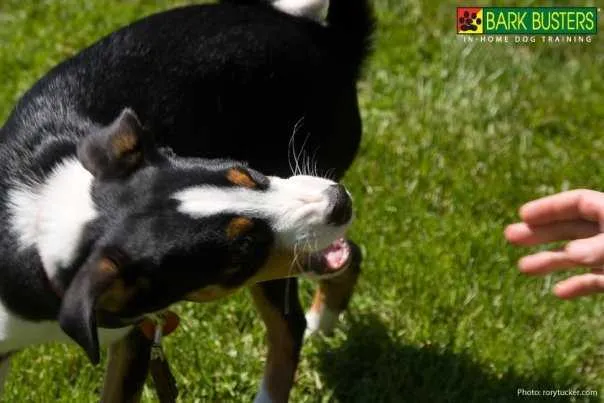Is Your Dog Aggressive?

As Bark Busters trainers, we are often called upon to help dog owners overcome aggression. In fact, we are one of the few training companies able to deal with this behaviour. Many dog owners are frightened that their dog's aggression cannot be curbed. However, with patience and the Bark Busters training methods, we can make behavioural changes no matter how severe the aggression is.
Understand that all dog aggression is based on fear - fear of pain, fear of other dogs, and even fear of you! What's important is to get to the root of the behaviour and understand what triggers your dog to become aggressive or anxious. What are the sequence of events and circumstances that occur before the dog becomes aggressive?
There are many different types of dog aggression. The main ones include:
- Fear-Based aggression
- Food aggression
- Material aggression
- Possession aggression
- Redirected aggression
- Territorial aggression
- Aggression with other dogs
- Aggression towards humans
- Pain-induced aggression
- Predatory aggression
- Medically based aggression
Understand that when it comes to aggression, there is no "one size fits all" approach. Different types of aggression will involve different training. We are going to talk about the most common type of aggression - fear aggression. Understand the below guidance is meant to be interpreted as general information and not as instruction, training or diagnosis for your dog's specific behaviour. With aggression, it's always the best course to hire a professional trainer.
Fear-Based Aggression
You've heard the expression "fight or flight" response? Many times, when a dog encounters something scary, they will do one of two things: 1) run away or flee; 2) fight something or someone they are afraid of.
Fear-based aggression is normally very easy to recognise because you will see it and hear it. The dog will have their ears pinned to their heads, their mouths open and panting while their teeth are bared, and their eyes squinting or so far to the side that you can see the whites of their eyes. Their tail may be neutral to down and wagging (a wagging tail DOES NOT necessarily mean a dog is happy!). If the dog approaches, it tends to be from the rear or side as they are not comfortable approaching from the front (remember they are scared). The dog may be trying to avoid confrontation versus causing it or inviting it, hoping to intimidate and cause a retreat. Fearful dogs will often "snap and retreat" because they're trying to get the thing, person, or dog away rather than trying to inflict damage.
Fear aggression often occurs on the dog's home turf or on lead when the dog doesn't have the option to retreat. Remember that a dog that is cornered or tethered is more likely to be aggressive because they cannot flee. We often hear about dogs that are highly aggressive on lead but mellow off lead with dogs and/or humans. Remember that a lead limits the dog's ability to leave so it feels it must hold its ground and fight.
When your dog feels like it is their job to take care of you and to provide you with safety and security, they will likely be highly agitated when encountering anything that could (in the dog's mind) be a threat. Remember that dogs are pack animals and therefore it's not in their nature to leave their territory and mix with other packs/dogs.
Dogs who were not socialised properly as puppies are more likely to have many fears - and therefore fear aggression - than those who were introduced to a wide variety of smells, dogs, and people as puppies. Dogs who were abused are also more likely to have a lot of fears that they approach with aggression.
The worst thing you can do with a fear-based dog is to use punishment-based techniques that can make the situation worse. Actually, Bark Busters believes the only hand you should lay on your dog is a loving one.
The resolution for fear-based dog aggression is to focus on helping your dog to understand that no matter what comes along, YOU have "got this". You are the "Leader of the Pack". Doorbell rings - you've "got this", dog approaches - you've "got this" etc. In other words, your dog should be looking to you to provide their safety than the other way around. Remember, this is about your dog's perception. You might feel safer with your dog but if you want to resolve your dog's aggression you must make them feel safe with you at all times.
What Makes Dogs Fearful?
Dogs have different things that trigger their fear response. Unfamiliar dogs and people are at the top of the list. Children are up high on that list because they don't know the right way to approach a dog. Kids often poke and prod dogs and pull on their ears and tails.
Loud noises can cause fear. Fireworks are especially terrifying. No wonder one of the busiest days for shelters are after New Year's Eve and Australia Day. Even thunder can cause fear.
Can every aggression case be 100% resolved? The short answer is no but most can get to 99%. The good news is that all dogs are trainable and if you have an aggressive dog, there is always a way to train and manage the dog successfully.
Recent Articles
- Dog Training for Snake Safety: Essential Tips for Australian Pet Owners
- Dog Aggression Training & Tips
- Leash Training - How to Stop your Dog from Pulling on Walks
- Halloween Safety Tips for Dog Owners
- Understanding and Training Dogs with Separation Anxiety
- Why Is My Dog Barking So Much? Understanding Excessive Barking and How To Help
- Dogs need education too!
- Winter woes? A dog-lovers guide to solving winter blues
- Natural Dog Behaviours
- Indoor Boredom Busters for Your Dog
